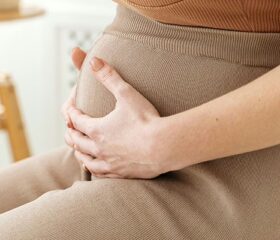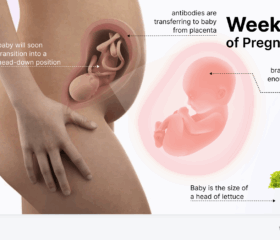Symphysis Pubis Dysfunction: Signs, Causes, & Treatment
Symphysis pubis dysfunction (SPD) is a condition that affects a significant number of pregnant women. It affects the pelvic joints, muscles, and ligaments, and can make even the slightest movements a struggle.

If your pregnancy is saddling you with entirely too much pelvic stretching, the good news is that there are things you can do to manage this condition. Let’s take a look at SPD, its symptoms, and what you can do to make the pain go away.
What is symphysis pubis dysfunction (SPD)?
SPD, also called pelvic girdle pain (PGP), happens when the ligaments surrounding the pubic symphysis joint at the front of your pelvis become too relaxed and stretchy. It’s sometimes known as lightning crotch, as the pain can feel sharp and shooting like an electric shock.
Think of the pubic symphysis as a pelvis stabilizer. Your ligaments normally hold it in place so that your pelvic bones can move evenly and comfortably. 1
When you’re pregnant, your body releases a hormone, relaxin, that loosens your body up for childbirth. 2 This is usually a good thing, but sometimes, your body may go overboard with it.
Combine this with the pressure from your growing baby (which can also lead to other common pregnancy pains, like rib pain and round ligament pain), and you’ve got a recipe for premature or excessive instability, pain, and discomfort from extra pelvic shifting.
Diagnosed cases of SPD are relatively common, occurring in around 1 in 5 pregnancies, with some experts estimating that up to 25% of pregnant women experience the condition to some degree. 3 4
Other causes of SPD
While relaxin is the primary culprit behind this condition, several other factors can increase your risk of developing it, including: 3
- Experiencing SPD in a previous pregnancy.
- Having a history of pelvic injuries (e.g., from a car accident or sports).
- Being overweight.
- Carrying twins or other multiples.
- Having a large baby (macrosomia).
What other complications can SPD lead to?
While SPD is one of the more uncomfortable pregnancy symptoms you may have to contend with, most cases aren’t much of a concern. However, in rare cases, it can lead to severe complications during childbirth and the postpartum period.
One of the more alarming issues it can cause is pubis symphysis diastasis (PSD). This condition occurs when the pubic joint widens so much that it separates or dislocates during labor (without causing a fracture). 5 6
PSD is very painful and could require more intensive treatment after delivery, like bracing and physical therapy. 7
How can you tell if you have symphysis pubis dysfunction?
SPD’s symptoms range from mild discomfort to severe pain. Most commonly, the pain is centered on the pubic area, but it can also hit the lower back, upper thighs, and perineum (the area between the vagina and anus).
Expect to feel a stabbing or wrenching sensation, like your pelvis is tearing apart. You might also hear a clicking or grinding sound in your pelvic region. 8
SPD is aggravated by movement. You may trigger the pain by:
- Walking
- Climbing stairs
- Getting dressed
- Turning over in bed
- Getting in and out of your car
- Standing on one leg
Your doctor will confirm your condition with a physical exam to check your posture and the range of movement in your hips and back.
How to manage SPD during pregnancy
While SPD is no picnic, there are ways to handle it and reduce your pelvic pain during pregnancy: 9
- Avoid triggering activities: Limit movements that worsen your pain, such as pushing and twisting motions. Sit down when getting dressed, and ask your doctor how much you can safely lift while you’re pregnant (hint: probably a lot less than you’re used to).
- Apply heat or cold: Give your pelvic area temporary relief with a heating pad or ice pack (although you should avoid applying heat directly to your abdomen when you’re pregnant, so don’t do this if the heating pad gets too hot).
- Wear a pelvic support belt: This helps stabilize the pelvic bones and reduces pain when you move.
- Practice pelvic floor exercises: Don’t skip your Kegels and pelvic tilts. These strengthen your pelvic muscles.
- Change how you sleep: Avoid the wrong sleeping positions for pregnancy (e.g., lying flat on your back) and, instead, sleep on your side with a pillow between your knees to minimize the stress on your hips and lower back.
- Take it easy getting in and out of the car: Sit down first and swing both legs out together—no wide leg movements for you.
- Maintain good posture: Stand and sit upright to limit pelvic strain.
If none of that works, consider physical therapy. A professional can recommend other tactics to ease your pain and improve your pelvic function. You could also look into getting a prenatal massage that’s geared towards alleviating the pain of SPD.
How long will your post-birth recovery take?
After giving birth, you might still suffer from the aches and pains of SPD. You’ll be glad to hear that with the right treatment, most women can get back to their normal, active selves 3 to 4 months after delivery. 9
When to speak with your doctor
Give your doctor a call if you think you’re showing signs of SPD. Report any pain that interferes with your daily activities, makes it hard to urinate or move your bowels, or persists after delivery. It’s always good to be on the safe side, and when it comes to SPD, that means getting a proper diagnosis and treatment plan.
Final thoughts
SPD is temporary and should leave you alone after your little one arrives. In the meantime, try not to let it wreak havoc on your nerves and quality of life. Guard your mental health just like your physical health.
As with everything else pregnancy has thrown your way, you’ve got it in you to handle SPD like a champ.
Article Sources
- Royal College of Obstetricians and Gynaecologists. "Pelvic girdle pain and pregnancy" Retrieved April 30, 2025.
- You and Your Hormones. "Relaxin" Retrieved April 30, 2025.
- Tommy’s. "Pelvic pain in pregnancy (SPD)" Retrieved April 30, 2025.
- European Spine Journal. "Pregnancy-related pelvic girdle pain (PPP), I: Terminology, clinical presentation, and prevalence" Retrieved April 30, 2025.
- Radiopaedia. "Postpartum pubic symphysis diastasis" Retrieved April 30, 2025.
- Journal of Rehabilitation Research and Development (JRRD). "Diastasis of symphysis pubis and labor: Systematic review" Retrieved April 30, 2025.
- UCSF Department of Radiology & Biomedical Imaging. "Ultrasound-Guided Injection Relieves Pain, Enables Mom to Care for Newborn" Retrieved April 30, 2025.
- Pathways. "Pelvic Pain: Symphysis, Pubis, Dysfunction" Retrieved April 30, 2025.
- Lamaze International. "Seven Things to Know About the Pain from Pubic Symphysis" Retrieved April 30, 2025.







